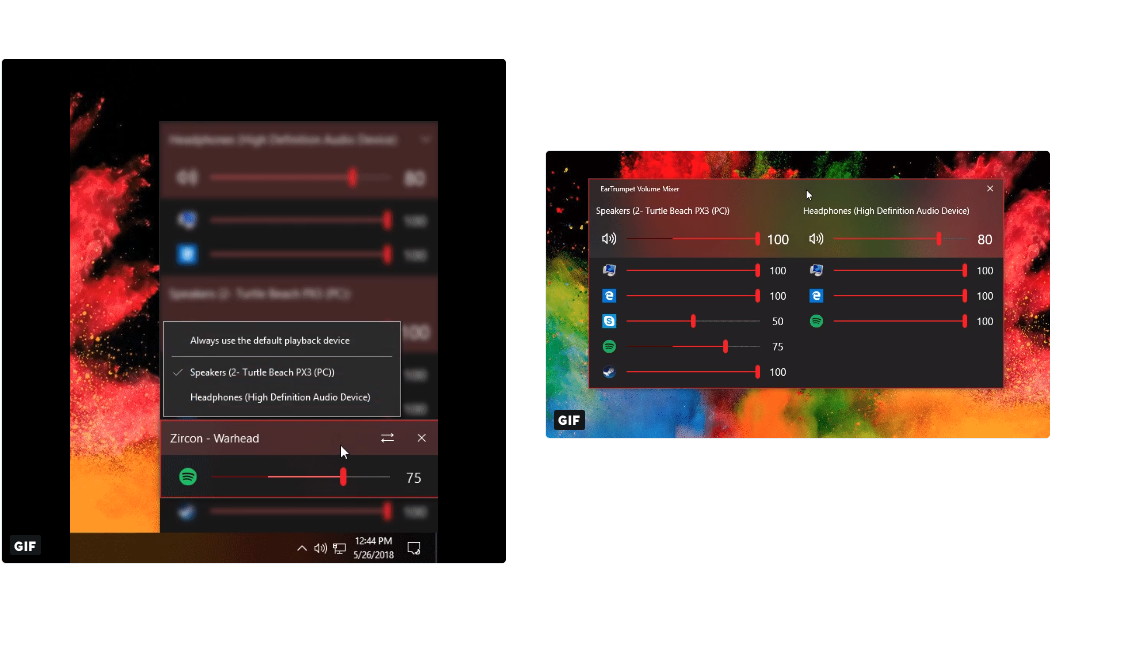Volumemixer-app.com
Adjusting the volume and changing the system sound settings on Windows 10 has always been a straightforward process, but you were only able to manage them using Control Panel. However, starting with the, you can now manage speakers and microphones settings, and it's also possible to adjust the volume on apps and system sound individually using the Settings app. In this, we walk you through the steps to change the sound settings using the new options available starting with the April 2018 Update. You can also click the Device properties link, which opens additional speaker settings using the Control Panel experience:. General — You can enable or disable the speaker and access audio driver information. Levels — Allows you to adjust master volume and balance settings. Enhancements — Includes settings to enhance audio with special effects.
Nov 20, 2018 They're open and running, but don't consistently (or EVER) appear in the mixer. This thread is locked. You can follow the question or vote as helpful, but you cannot reply to this thread. To create Volumemixer App review we checked Volumemixer-app.com reputation at lots of sites, including Siteadvisor and MyWOT. Unfortunately, we did not find sufficient information whether Volumemixer-app is safe for children or does not look fraudulent. In fact, the total size of Volumemixer-app.com main page is 5.6 MB. This result falls beyond the top 1M of websites and identifies a large and not optimized web page that may take ages to load. 60% of websites need less resources to load.
Advanced — Allows you to change default sample rate and bit depth. Spatial sound — Includes the options to use Windows 10's spatial sound format, including 'Windows Sonic for Headphones' and 'Dolby Atmos for Headphones.' Similar to using the speaker icon in the taskbar, on the Sound page you can also change the system master volume with the slider.

You'll also find a Troubleshoot button that starts the audio troubleshooter to fix common sound problems automatically. You can also click the Device properties link to open additional microphone settings using the Control Panel experience:. General: You can enable or disable the speaker and access audio driver information. Listen — Lets you allow or deny the microphone to listen to your speakers, and you can customize power options.
Levels — Allows you to adjust the volume and balance settings for the microphone. Advanced — Allows you to change default sample rate and bit depth. The Input section also includes an indication to test if your microphone is working, and if it's not, you can click the Troubleshoot button to open the microphone troubleshooter to fix common problems. You'll notice that the 'Volume Mixer' is still accessible, but it'll eventually go away as these settings can now be found in 'App volume and device preferences' page. How to manage advanced Windows sound options using Settings The new Sound settings also include a number of advanced options to control volume and input and output devices.
Volume Mixer App Windows 10
(This experience replaces the Volume Mixer, which is still available in the April 2018 Update.) To access and customize app volume and device preferences, do the following:. Open Settings. Click on System. Click on Sound. Under 'Other sound options,' click the App volume and device preferences option. The first thing you'll find on this page is the slider to control the system master volume and adjust all sounds.
On the right, there are two drop-down menus to select the default speaker and microphone, which are the same settings that you can customize in the Sound page. At the bottom of the page, you can adjust volume for specific apps and system sounds as a percentage of the master volume.
Alongside the ability to change the volume for apps and system individually, this page also allows you to select the default output and input device if you have multiple speaker setups and microphones. If you want to revert all your changes, you can use the Reset button to roll back to Microsoft's recommended sound settings. Wrapping things up Although the April 2018 Update finally ports the sound options to the Settings app, you'll still need to use the Control Panel experience to change more advanced properties.
Add Applications To Volume Mixer
However, eventually, those options are also expected to move in some form to the Settings app. More Windows 10 resources For more helpful articles, coverage, and answers to common questions about Windows 10, visit the following resources:.
Volume Mixer App For Windows 10
It’s called Volume Mixer. This simple app supercharges your volume control on a Mac by allowing you to easily lower or raise an app’s volume on an app-by-app basis, thanks to an individual slider. Many Mac apps let you adjust the volume within the app itself, but Volume Mixer is an all-in-one solution that sits in your menu bar, allowing you to adjust volume no matter where you are in an OS X stack. It’s long overdue, especially since the capability has been. Sadly, Volume Mixer is a little pricey on the Mac: It costs $10, with a free 15-day trial. But if you juggle a lot of multimedia apps, it might be well worth the cost.